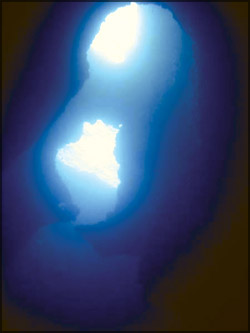 Blue
holes in the ocean? Blue
holes in the ocean?
Most of you may have heard of or read about black holes in space, but
are you aware of the existence of something called blue holes in the
ocean? Most probably not.
However, ocean blue holes do exist and they are considered to be
unique and also one of the most fascinating natural environments in the
world. So, letís take a dive into these deep blue holes to find out more
about them.
|

Inside a blue hole |
What exactly are blue
holes?
Blue holes, also known as submarine caves, vertical caves or
sinkholes, are roughly circular subterranean caves or steep walled
depressions(hollows on the surface).
They are a phenomenon (remarkable thing) created during the ice ages
when sea levels were much lower - about 100-200 mt lower than at
present. They are actually limestone cave formations which have been
subjected to the same chemical weathering common to all limestone-rich
terrain.
At the end of the ice age, the roofs of many of these caves collapsed
with the weight of the water and they were filled with water. Today
these submerged caves and cavities are known as blue holes; there are
inland blue holes (found on land) and marine or ocean blue holes.
Why are they known as
blue holes?
The drastic contrast between the dark blue coloured water (due to the
depths of the holes) and the lighter blue water of the shallow area
around them, has led to these deep, roughly circular and steep
depressions to be called blue holes.
Where can they be
found?
Typically found on shallow carbonate platforms they can be found
mostly around the Bahama Bank and Mexicoís Yucatan Peninsula, such as
the Lighthouse Reef Atoll-Belize located in the Caribbean.
All the main islands
of the Bahamas have blue holes.
The largest island of Bahamas, Andros Island has 178 on land and 50
in the sea. They can be described as entrances to the cave systems which
run under the island and sea floor. The Bahamas blue holes are
considered to be some of the best natural laboratories to study the
geological past as many of them are pristine (unspoilt) and unique.
The Bahamas archipelago consists of a chain of islands and shallow
water Ďbanksí which stretch from north east to south west, extending
some 1400 km from Florida to the Island of Hispaniola.
The entire region had been considerably affected by sea level changes
during the Pleistocene Ice Age.
In fact, as a result, Bahamas has the only known tidal blue holes in
the world. Affected by the ocean tides, these blue holes blow out and
suck in water. Cold, subterranian water which may be milky with hydrogen
sulphide and algae is pumped out while water which is crystal clear from
surrounding sea water is sucked in.
|

Deanís Blue Hole - the deepest in the world |
What are they like and
how deep are they?
The deepest blue hole in the world is called the Deanís Blue Hole and
is about 663ft in depth. Most other blue holes average a depth between
360 and 400 ft.
The Great Blue Hole, which is near the centre of Lighthouse Reef - a
small atoll 60 miles from the mainland Belize City - is circular in
shape. It is over 1,000 ft across and about 400 ft in depth. There are
other blue holes - the Blue Hole of Castalia (U.S) is one. It is an
inland blue hole.
The Great Blue Hole of Belize is considered to be one of the most
astounding diving sites in the world, like most of the other blue holes.
Even though blue holes are not favourable environments for most sea
life, a large number of bacteria and other species are found in blue
holes. Most of these depressions are so awesome to look at that they
have become a divers; paradise today.
In fact, it is said that Jacques Cousteau pioneered a route into the
Great Blue Hole, in his famous research ship Calypso in 1972 and this
route is now used by the diving trade. He declared it as one of the ten
best sites in the world for scuba diving.
Continued next week |
